Silkworm caterpillars: types and control measures
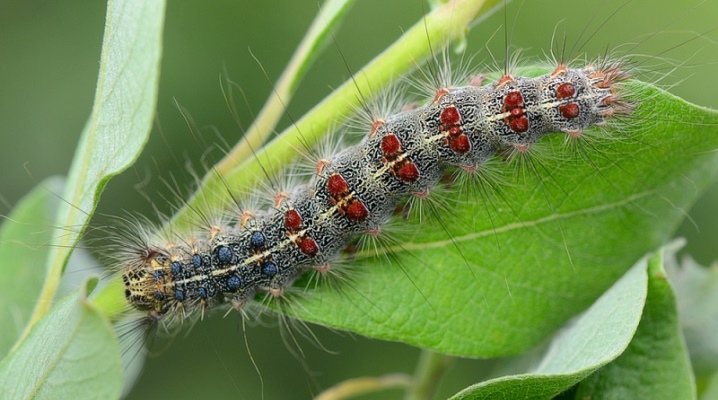
Silkworms are common insects, they are capable of infecting about 300 species of vegetation. The pest prefers trees in the garden, as well as oak and pine. In the absence of control of these voracious caterpillars, large areas of gardens can be destroyed, as well as irreparable damage to agriculture.
Pest varieties and how they are dangerous
Silkworms look like butterflies, which are characterized by the original folding of the wings, which distinguishes them from other representatives. Eggs in the clutch of an insect are called grenes. The latter are capable of growing and shedding. Caterpillar development can take 26-32 days. The silkworm weaves a special shell for itself, thereby pupating. The length of one silk thread is from 1500 meters.
In a self-created cocoon, the silkworm caterpillar becomes a pupa, and after 2-3 weeks it turns into a butterfly. This creature does not pose a direct danger to human health, but it can greatly harm plants. Currently, many species of silkworm can be found in nature, each of which eats a specific type of plant.
The voracious insect feeds on usually succulent foliage, eating it in large quantities.
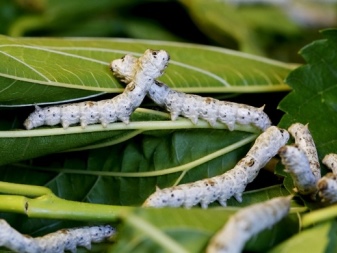
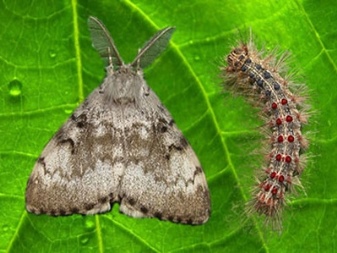
Mulberry
The silkworm is a real butterfly - the manufacturer of silk threads. He practically does not know how to fly and often settles on a mulberry tree (mulberry). Insect larvae eat foliage in large quantities throughout the day. This creature looks rather inconspicuous and bears some resemblance to an ordinary bloodworm or moth.
The caterpillar, which has pupated, begins to make a cocoon from a thin silk thread. The latter can be colored white, pink, yellow and green. In order for the productivity of silkworm thread production to be high, the insect needs special conditions.
The climate in the territory where this voracious creature lives should be warm with moderate humidity and a lot of plants.
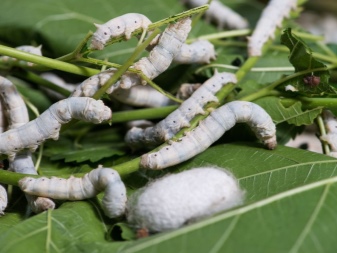
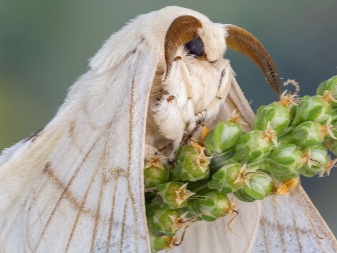
Unpaired
A quarantine pest in the form of a gypsy moth is characterized by a significant difference between males and females. Females are light yellow in color and have a wingspan of about 9 cm. The male half is brown-yellow, with a wingspan not exceeding 4 cm. The gypsy moth lives on 300 species of plants, including fruit trees and valuable crops. This insect belongs to the most dangerous among their relatives.
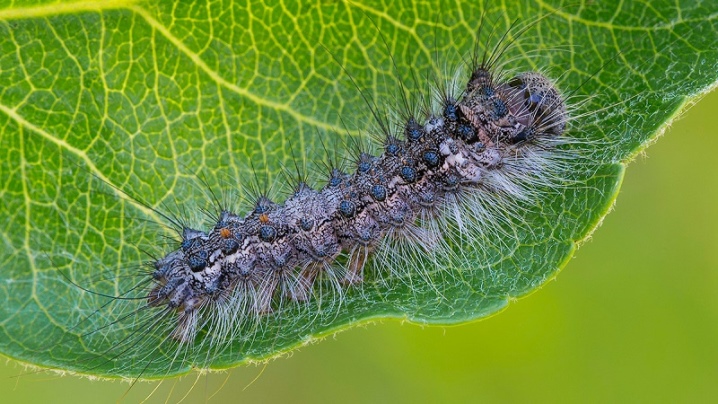
Siberian
The Siberian silkworm is considered a forest pest. A large butterfly outwardly looks rather inconspicuous. Often, the female cocoon moth is much larger than the male. The body color of the insect is yellow-brown or light gray. An insect is good at disguising itself as a tree trunk of a particular species. Siberian silkworms are quite common on the territory of the Russian Federation.
The larvae that have just hatched from the eggs are actively consuming food. They like the young needles of trees. These voracious creatures move to the top of the plant, eating everything in their path, thereby destroying the representatives of the flora. The enemies of the Siberian species of silkworms can be called riders, flies, takhins (hedgehogs), egg-eating riders. The danger of the pest lies in the fact that its population can increase 100 times in several circles of development.
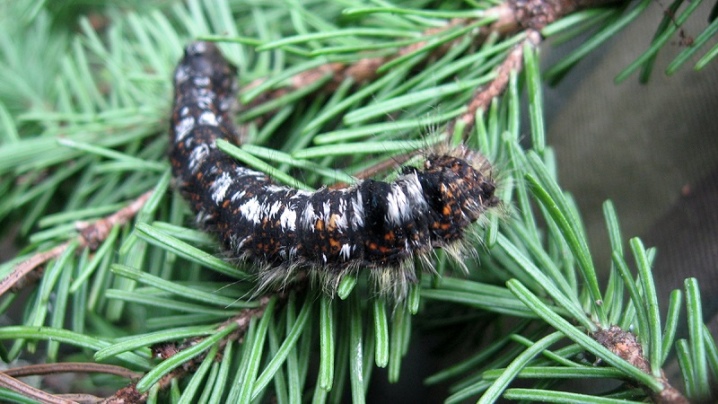
Herbal
A large herbaceous butterfly of the genus of cocoons has a red-brown color. This insect is distinguished from others by the presence of white spots on the upper part of the wing. In females, the body size is larger, the abdomen is thicker. Males have large comb-like whiskers and dark colored wings. The herbal silkworm can be found in the steppe and forest-steppe. This insect prefers humid biotopes, ravines, humid lowlands, near shores with active vegetation.
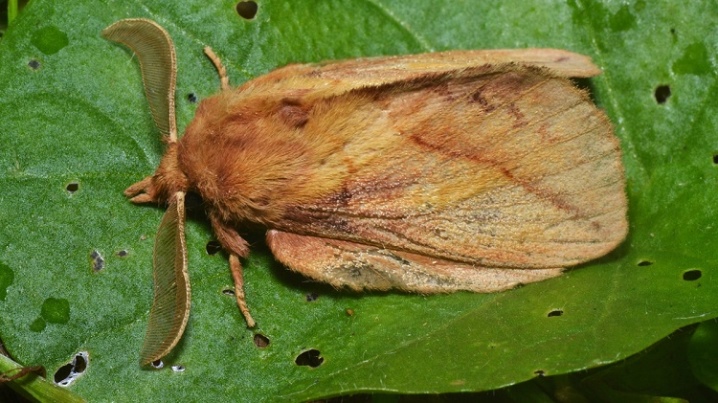
Marching
Traveling silkworms belong to the family of butterflies. Their caterpillars have a well-developed instinct to migrate to a new feeding place. The insect has a gray or yellow-gray color, their wingspan is 4 cm. The whole body of this creature is covered with hairs.
In the event of mass reproduction of marching silkworm caterpillars, entire forests and tracts may disappear. The insect's food is the foliage of trees. The caterpillars of this pest are characterized by the presence of poisonous hairs. In case of contact with human skin, an inflammatory process occurs.
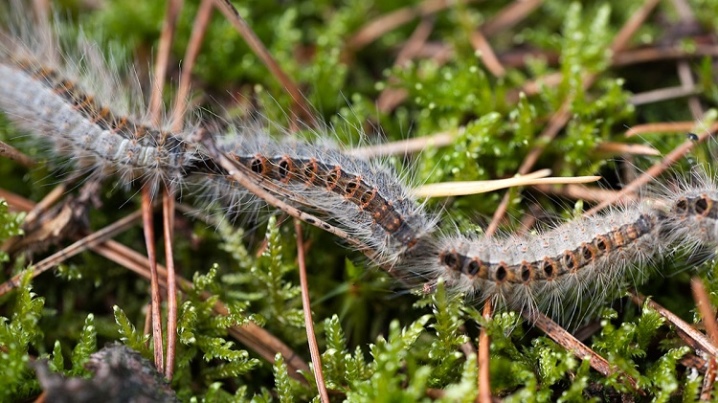
Pine
Pine can be attributed to a large variety of silkworms. In adult form, this species is capable of spreading its wings 8.5 cm. The insect is gray-brown in color, but light specks can be found on the front wings. As a rule, the color of the silkworm's cover can change depending on the color of the bark of the tree on which it lives.
The caterpillar of the pine silkworm is characterized by furry, gray coloration with the presence of brown hairs... This type of insect can be found on a coniferous tree, usually pine. The caterpillar's diet contains needles, as well as young shoots.
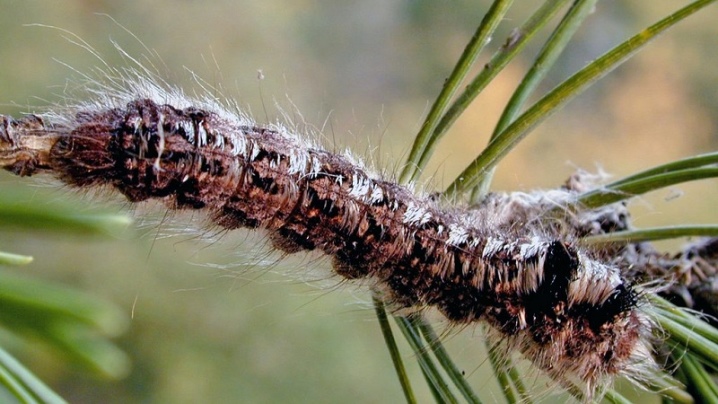
Birch
You can meet the birch silkworm in the old-growth and middle-aged forest. Typically, such areas are dominated by birch trees and undergrowth. The insect has a light brown color and a whitish coating. On the head, back and abdomen of the silkworm, you can see fluffy yellowish hairs.
This type of butterfly is found in deciduous and mixed forests, where there are many birches. Caterpillars are fed on birch, linden, hazel.

Oak
The southern and eastern part of Eurasia is considered to be the habitat of the oak silkworm. He feels most comfortable in countries with a warm climate, for example, Malaysia, India, Indonesia. Caterpillars prefer to eat oak, chestnut, hornbeam leaves.
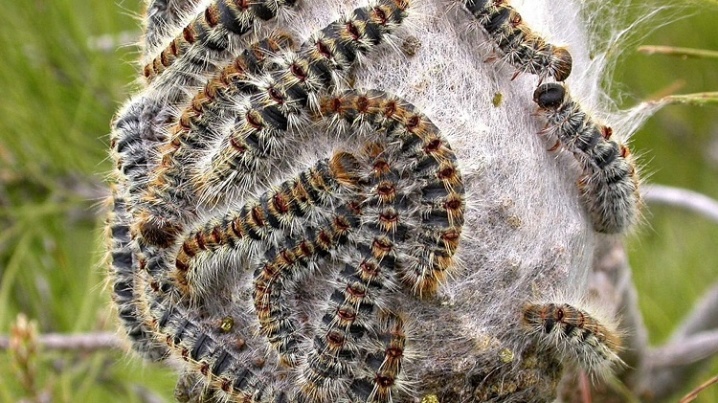
Ringed
Ringed silkworms are medium-sized moths that are yellow-brown in color. The wingspan of this creature can be 4 cm. At a young age, the caterpillar is black, but as it matures, it acquires a bluish-gray tint. The female ringed silkworm lays eggs, which are shaped like rings around the branch.
Caterpillars can cause tremendous damage to the economy, especially to fruit trees such as pear, plum and apple trees. In the event that insects do not have enough food, they can attack bushes, oak and poplar.
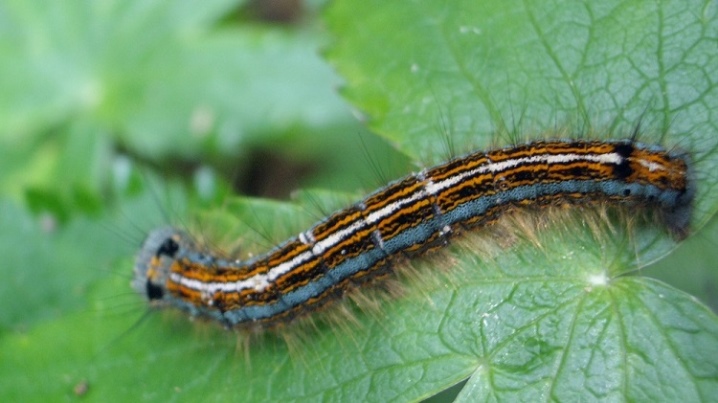
Harpy big
The harpy moth is characterized by a wingspan of 5.8-7.5 cm... The large insect is light gray with matte zigzag lines. There are thick white hairs on the head and chest of the harpy. The area of distribution of this species of silkworm can be considered the whole of Europe.
The creature lives mainly in floodplain forests, along water bodies and streams. In addition, it can be found in the poplar alley. The silkworm feeds on poplar, aspen foliage and willow greens.

Control measures
The fight against silkworms in the summer cottage should be carried out in a comprehensive manner. During one season, insects can destroy young individuals of garden trees, as well as minimize their yield. The basic principles of saving crops in the garden and garden from the gluttonous larva:
- you can collect the pest from young low trees with your hands;
- it is advisable to attract natural enemies of the silkworm to the site;
- in early spring, after the snow melts, it is recommended to apply a layer of slaked lime to the trees;
- before the migration of caterpillars, plants should be treated with special preparations.
If you make every effort, then you can get rid of the pest on the trees in a season. In this case, it is desirable to use several methods at the same time. The main methods of dealing with silkworms on apple and other horticultural crops.

Biologicals
The use of biological products based on active bacteria. The latter are capable of infecting the internal organs of insects and their systems. After using a biological product, you can immediately notice the onset of a destructive effect. The results of the procedure can appear 7-10 days after treatment. In case of rains, the effect of the substance on the pest is significantly reduced. Biologicals can be used at different stages of vegetation vegetation. A good result is observed when using the following substances:
- "Bitoxibacillin" - sprayed plants during the growing season with an interval of 8 days;
- "Entobacterin" - used only at a temperature of plus 20 degrees;
- "Dendrobacillin" - refers to fast-acting drugs;
- Fitoverm;
- "Lepidocide";
- Bio Sparks.
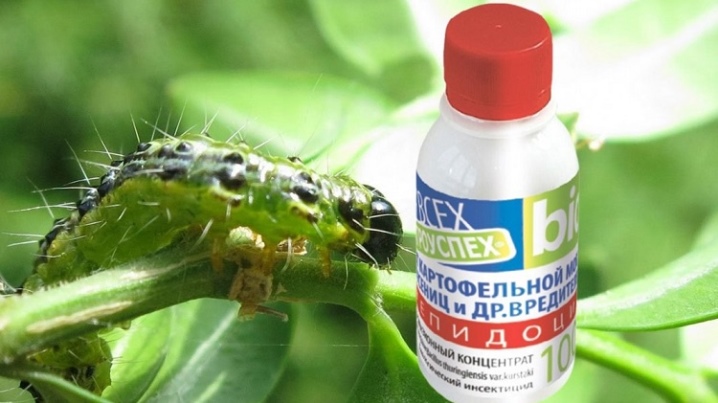
Insecticides
Chemical agents in the fight against silkworms bring results within a few days. In the case of using the poison, the butterflies die in a few hours from the moment of irrigation, the caterpillars die within a month. The penetration of the poison occurs through the chitinous cover of the pest, after which the nervous system is damaged, muscle paralysis and death. Since the poison penetrates into the sap of the tree a couple of hours after irrigation, the absorption of insecticides by silkworms is carried out at the time of their feeding. It is recommended to pick trees in the garden several times per season. When processing in early spring, spraying can be done once.
According to gardeners, silkworm control can be effective if you use:
- Actellik;
- "Aktaru";
- "Karbofos";
- "Fufanon".
The use of insecticides is recommended only after all other methods have proven ineffective.
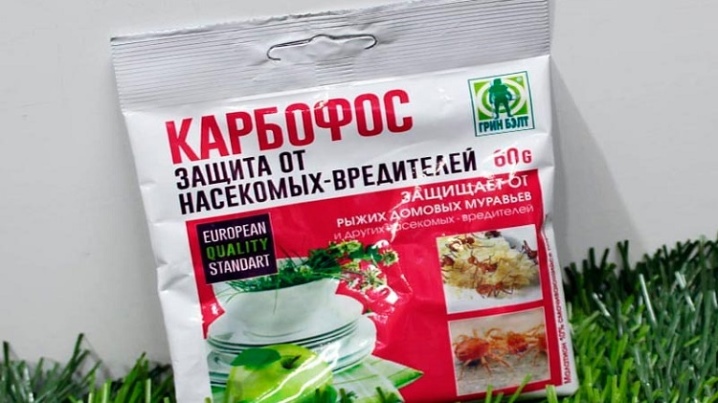
Folk remedies
There are simple and safe methods to kill silkworm caterpillars. For this purpose, the gardener should apply:
- herbal decoction with a pungent aroma;
- laundry soap;
- spices;
- wood ash;
- table vinegar;
- ammonia.
With the help of a soap base, the active components are retained on the foliage. Soap can be added to all folk remedies necessary to combat silkworms. A good effect is observed if garden crops are treated with garlic tincture. Everyone decides on their own how to deal with silkworms. In order to choose the right method, the gardener must evaluate many factors.

Prevention of spread
Silkworm caterpillars are a huge danger, therefore prevention is considered the best measure for their elimination. Basic preventive measures.
- Mechanical elimination of clutches located on plants... This is a fairly simple procedure, during which you need to carefully examine the garden crops and check for nests on them. Experts strongly advise to carry out the collection in protective gloves, as an allergic reaction may occur after the procedure.
- Plant processing active compounds.
- Spraying special preparations.
- Elimination of cocoons during flowering vegetation. This method will prevent the appearance of the larva, as well as significantly reduce the insect population.
From the above, we can conclude that silkworms benefit humans. However, in this case, the insect can cause serious harm to horticultural crops.In order to eliminate the pest and prevent its spread on the site, it is required not only to detect the insect in time, but also to take the right measures to combat it. Experts strongly recommend using several methods to eliminate silkworms. Also, gardeners are advised to use chemicals only when folk remedies and biological products have not shown results.
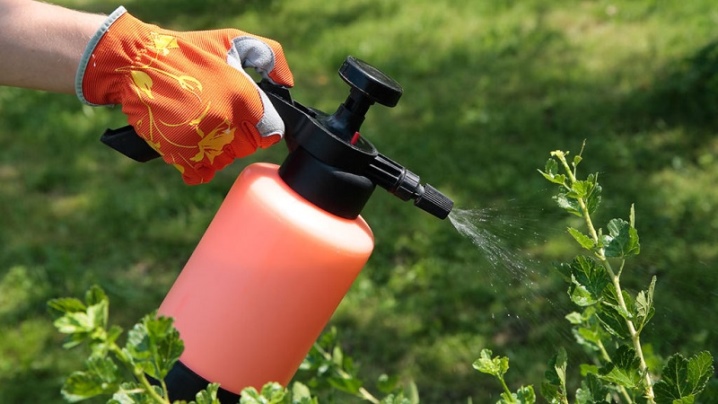













The comment was sent successfully.